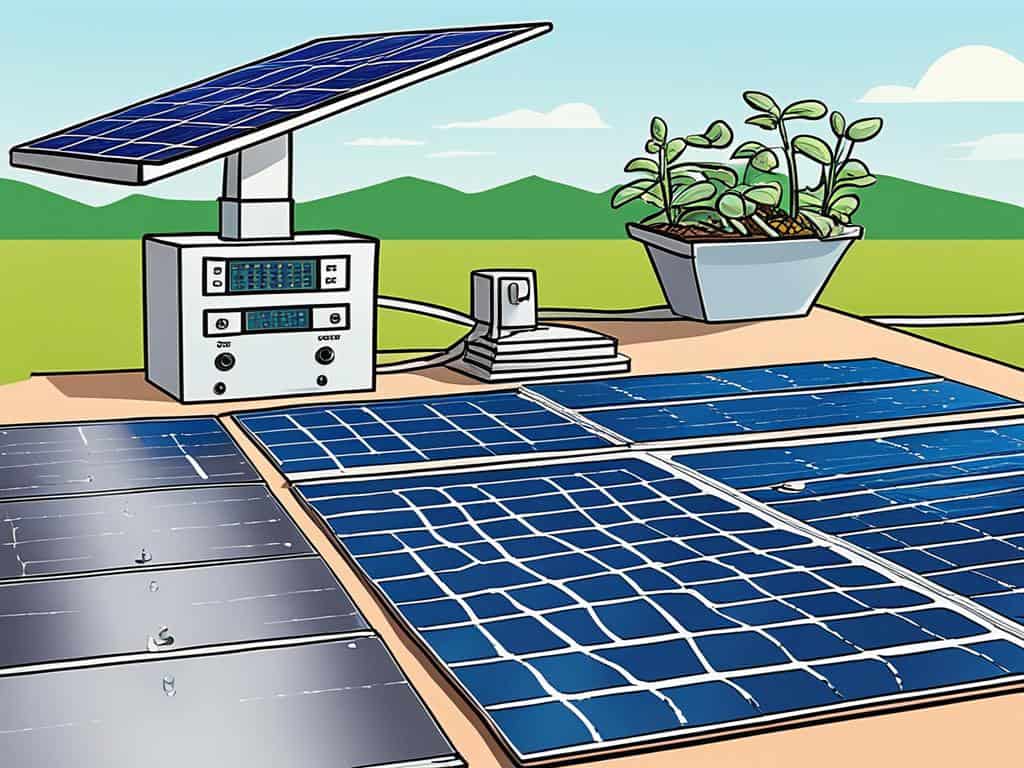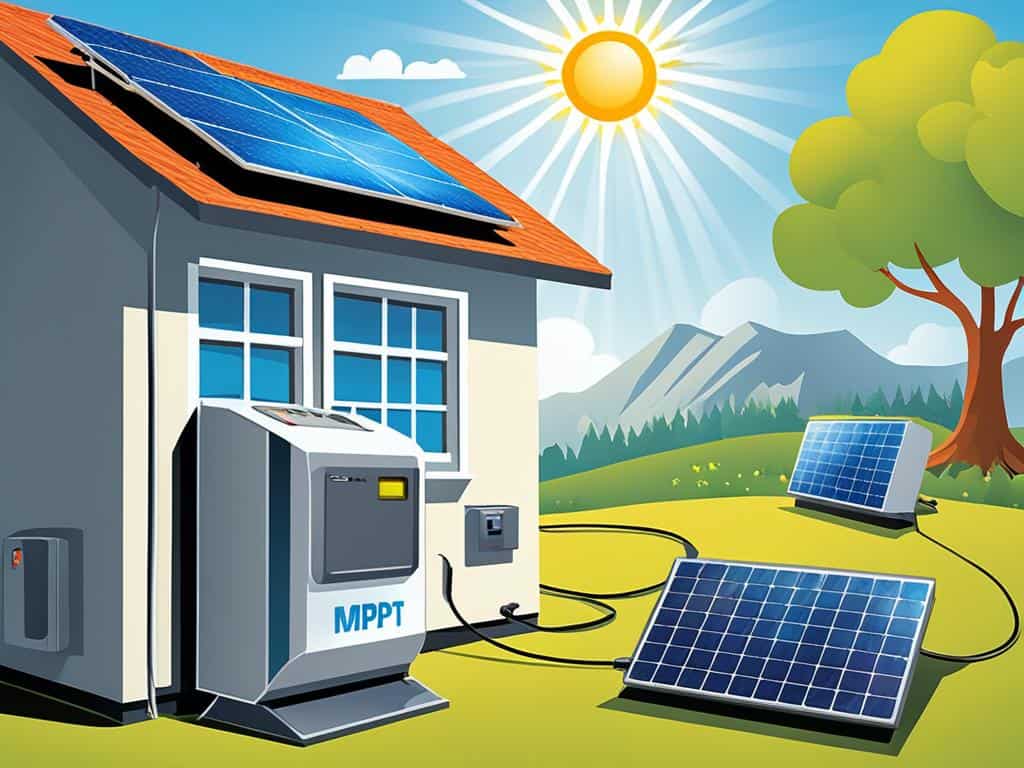Enhancing Solar Efficiency with MPPT Solar Charge Controllers: Benefits and Setup Guide
Unlock optimal solar panel performance with an MPPT solar charge controller. Learn the benefits and get a step-by-step setup guide for your system.

Are you getting the most out of the sun’s power? The mppt solar charge controller steps in to upgrade how much energy your panels capture. It acts as a smart middleman, boosting the energy flow between panels and batteries. But why choose mppt over a simpler solar panel charge controller?
A solar power controller has one main job: charging batteries and keeping them safe from overcharging. The MPPT model does this with superior efficiency and cost-effectiveness. Companies like Fenice Energy push for more advanced solar solutions like the MPPT in evolving markets.
MPPT technology isn’t just for tech-savvy folks. We’ll explain its benefits in simple terms. Adding a high-quality solar battery charger like MPPT is not just nice to have. It’s an essential move for better renewable energy use.
Key Takeaways
- Discover the significant efficiency boost MPPT controllers offer over their PWM counterparts.
- Learn why modern MPPT controllers are recommended for maximized energy generation.
- Gain insight into the compatibility and effectiveness of MPPT controllers with various battery technologies, particularly lithium-ion.
- Explore the cost implications and long-term savings associated with investing in high-performance MPPT controllers.
- Understand the proper sizing approach for solar charge controllers to prevent power loss.
- Realize why Fenice Energy recommends MPPT controllers for larger setups in the Indian solar market.
Introduction to Maximum Power Point Tracking Technology
The MPPT solar charge controller started a big change in solar power. It made photovoltaic systems much more efficient. MPPT is a method that helps get the most power from solar panels anytime. This is very helpful in areas where the weather changes a lot.
Understanding the MPPT Solar Charge Controller
An MPPT solar charge controller is a smart solar regulator. It acts like a dynamic converter, changing DC to DC. It makes sure solar panels work at their best voltage, named the “maximum power point.” This boosts the performance of solar battery chargers, making sure that batteries get the best charge. This helps batteries last longer and work better.
MPPT uses high-tech gear and methods like Perturb and Observation to fight power loss. This can happen because of low light or temperature changes. These controllers work at sounds between 20-80 kHz. So, they make sure energy changes are done very well. Usually, they are about 93% to 97% efficient.
Revolutionizing Solar Energy Harvest with Fenice Energy
Fenice Energy is a leader in the clean energy revolution. They use MPPT technology to improve solar energy use, especially in India’s varied climate. Fenice Energy makes solar power systems better. They work well even in less ideal conditions, which greatly improves solar installations.
For smaller power needs like IoT sensors or solar streetlights, MPPT technology has made things more efficient and cheaper. Also, MPPT controllers can offer a power boost of 20% to 45% in winter. In summer, the boost is about 10% to 15%. This shows they are better than old charge controlling methods.
| Feature | Benefit |
|---|---|
| Dynamic Power Tracking | Up to 52% increased efficiency at low irradiance levels |
| Design Optimization | Cheaper production costs for lower power applications |
| Enhanced Battery Charging | Meets specific lithium-ion battery charging requirements |
| Winter Performance Gain | 20% to 45% increased power gain in colder months |
| Frequency Operation | Efficient high audio frequency operation (20-80 kHz) |
| Microprocessor Control | Precise adjustments for optimal power conversion |
Using Fenice Energy‘s expertise in clean energy, people in India get top MPPT solar charge controllers. They not only perform well but also help in seeking energy freedom and sustainability.
The Role of Solar Charge Controllers in Photovoltaic Systems
Renewable energy’s rise highlights the solar charge controller‘s role. In India, with its vast solar potential, solar panel charge controllers are essential for efficient sun power use. The global solar charge controller market is growing fast, expected to reach over INR 31,800 crores by 2027, thanks to an impressive 15.1% annual growth rate.
India is the world’s third-largest solar market. It installed 7.3GW of solar power in 2019. The country aims to install 175GW of renewable energy by 2022, with solar energy making up 100GW of this goal. By 2030, this effort will help make 60% of India’s total electricity from clean sources. This goal attracts about INR 6,07,200 crores in investments over the next four years.
The PV charge controller is crucial in photovoltaic systems. MPPT (Maximum Power Point Tracking) technology is becoming popular because it offers about 17% more power than PWM controllers. As solar power gets cheaper, the demand for advanced solar battery chargers like MPPT controllers is rising.
Companies such as Phocos have been supplying reliable PWM and MPPT solar charge controllers for over twenty years. These devices boost energy production and prolong the lifespan of solar systems. They prevent overcharging and improve power distribution.
The EnerTech MPPT Solar Charge Controller is noted for its high efficiency. It works with many battery types, including Lithium. This adaptability is crucial for modern energy storage needs.
| Feature | EnerTech MPPT Solar Charge Controller Specification |
|---|---|
| Charger Peak Efficiency | 95% |
| Maximum Power Point Tracking | Optimizes energy production |
| Input Voltage Range | Wide range handling capability |
| Voltage Regulation | Automatic |
| Battery Compatibility | Lead-acid, Lithium-ion, etc. |
| Protection Functions | Overcharge, over-discharge, short-circuit, reverse polarity |
| Operating Temperature | 0 to 50 degrees Celsius |
| Enclosure Protection | IP 20 |
| Dimensions | 250mm x 350mm x 450mm |
| Weight | Approx. 20-25 kgs |
Knowing these specs is vital for maintaining system performance in India’s climate. Advanced features, like current derating to protect components in high temperatures, show the sophistication of modern solar battery chargers. With MPPT controllers from EnerTech providing up to 30% more energy than PWM models, solar energy’s future in India is promising.
Maximizing Solar Panel Efficiency with an MPPT Controller
An MPPT solar charge controller unlocks the full power of solar systems. It boosts solar panel efficiency significantly. By using advanced maximum power point tracking, it keeps solar panels working at their best.
The MPPT controller adapts to changing sunlight levels, capturing the most power possible. Older controllers would let extra energy from solar panels go to waste. MPPT technology ensures every sunbeam is turned into useful energy. This is very important during the sunny times when panels work near their full potential.
MPPT stops power loss as heat, keeping solar panels cool and efficient. It adds more charge to the system’s battery consistently.
Fenice Energy sees MPPT technology as a top way to make solar power better and more cost-effective in India. MPPT controllers use special technology to adjust to different sunlight conditions. They are great at adapting to how the sun hits the panels.
MPPT controllers improve how solar cells capture light. Fill factors show the quality of the cells. They range from 70% to 90%. This means there’s a big chance to increase power conversion with MPPT.
MPPT controllers use smart algorithms to find the best power point. This boosts the energy captured, even when shadows cover parts of the panels. Shadows are common in places with many buildings.
Fenice Energy knows that for good solar solutions, materials matter. Materials like Polycarbonate or low-iron glass let through about 90% of light. This helps MPPT controllers make panels even more efficient.
| Technology | Efficiency | MPPT Suitability |
|---|---|---|
| Multi-cell Gallium Arsenide | 44% | High |
| Single-cell Gallium Arsenide | 29% | Medium to High |
| Crystalline Silicon | 25% | High |
| Thin Film CuInGaSe | 20% | Medium |
| Emerging PV Technologies | 11% | Low to Medium |
With MPPT controllers, solar panel systems can work 5%–20% better, say the makers. They are especially good for solar pumps, making them cost-effective compared to other types.
MPPT technology uses a smart DC–DC converter. It adjusts the load for maximum power. This makes MPPT a key part of better energy production.
Research shows Crystalline silicon panels are among the best for use. With efficiency between 15% and 21.5%, they match well with MPPT. MPPT works with all panel grades, making sure energy is used well.
Fenice Energy stresses the right setup for solar panels. Panels facing the sun directly or south for fixed setups work best. MPPT can even adjust for less sunlight in winter, keeping panels productive.
Maximizing efficiency with MPPT means panels always work near their best point. This approach boosts the energy efficiency and saves money for solar energy users in India.
MPPT Solar Charge Controller: A Game Changer for Solar Energy Collection
The use of MPPT solar charge controllers is transforming solar energy systems. These controllers boost the productivity of solar panels by a lot. They are key in modern solar technology.
Comparing MPPT with Traditional Charge Controllers
MPPT controllers are much better than PWM types. They can make solar panels 30% to 40% more efficient. This means they turn more sunlight into energy, which is great for off-grid places. Studies show these controllers make systems cheaper by making more power.
The Advanced Technology Behind MPPT Controllers
MPPT solar charge controllers are really advanced. They can find the best power point with almost perfect accuracy. They adjust to sunlight changes well without losing power. They also last longer and perform great, thanks to smart tech.

These controllers are getting more popular, especially in solar farms. Their success shows how good the technology is. They work with many battery types and have lots of safety features. This is big news for solar tech.
Fenice Energy is making great MPPT controllers. They combine excellent hardware with smart software. This makes them super efficient, up to 98%! Fenice’s products are changing the solar market in India, making energy independence closer.
Setting Up Your MPPT Solar Charge Controller for Optimal Performance
If you’re into solar power in India, using an MPPT solar charge controller is a big step forward. It helps you get the most out of your solar panels and batteries. This is key for efficient use of solar energy.
An MPPT solar charge controller is like the brain of your solar system. It adjusts the power from your panels to charge your batteries just right. This smart system is essential for anyone serious about solar power.
Brands like Victron and Renogy Rover lead with advanced technology. They make MPPT controllers that are 30% more efficient than PWM ones, given the right setup with your panels and batteries.
Adding a top-grade solar power controller lets you do more with your setup. For example, with a 24V battery system, you can connect double the solar panels than with a 12V system.
When choosing your controller’s size, think beyond the basics. Brands let you ‘oversize’ your solar array to ensure the controller works at its best. This boosts your system’s power without going over the max voltage and current.
Switching to a 48V battery system from 12V can cut down how much current you need. This means less energy is wasted, cables can be thinner, and stress on parts is less. It’s cheaper and parts last longer because there’s less heat and wear.
- Buck converters work well when the battery voltage is up to 48V.
- Boost converters are great for systems with a battery voltage over 48V.
Choosing the right mppt solar charge controller setup means matching it to your battery voltage. You also need to calculate the charge current from your solar panels. This ensures everything works together smoothly.
Using high-quality parts like the Max4080 current sensor helps your setup meet high standards. Tools like oscilloscopes are also important for a top-notch MPPT system.
For battery health, it’s crucial to handle them right. Lead-acid batteries should stay above 50% capacity to last longer. Lithium batteries offer more power but need careful handling to avoid risks. A good MPPT controller, with a Battery Management System, protects your batteries from damage.
Fenice Energy has been working with clean energy for 20 years. They see your MPPT controller as a smart investment for the environment and your wallet. Their experience shows that proper setup of these controllers is key for India’s sustainable future with solar power.
How an MPPT Solar Charge Controller Can Benefit Your Solar Setup
The solar energy sector is growing fast. With this growth, we see cool new technologies. One important tech is the MPPT solar charge controller. It’s a big deal in making solar systems in India work better. Using energy efficiently helps save money. The MPPT controller is key for any solar setup. Fenice Energy backs this technology because it makes solar panels work better. It also saves money for people in India.
From Enhanced Efficiency to Cost Savings
An MPPT controller makes solar panels much more efficient. It’s way better than older PWM controllers, with efficiency over 90%. This means real savings on your electric bills over time. The MPPT can work well with different solar panels and batteries. This includes the latest types, showing how flexible it is for many solar projects.
Why Fenice Energy Recommends MPPT Controllers for Indian Solar Market
Fenice Energy knows the Indian solar market well. They recommend MPPT controllers for a good reason. These controllers handle high voltage well, even when it’s cold. They might cost more upfront, but the benefits last a long time. They work great even when there’s not much sun. They make sure you get more energy, so they’re worth the initial cost.
| Charge Controller Type | Cost (INR) | Efficiency | Lifespan (Years) | Compatibility | Avg. Loss without Correct Sizing |
|---|---|---|---|---|---|
| PWM | 1,500 – 4,500 | Lower than MPPT | Up to 15 | Smaller Systems | Up to 50% |
| MPPT | 7,500 – 55,000 | 90% or higher | 10-15 | Monocrystalline, Polycrystalline, Thin-film | Minimized |

Choosing an MPPT solar charge controller is a smart move. It’s crucial for boosting a solar system’s efficiency. In the growing Indian solar market, Fenice Energy’s push for MPPT shows they want to support sustainable growth. They aim for better efficiency and cost savings, helping India be energy independent.
Adapting MPPT Solar Charge Controllers for Various System Sizes
Optimizing a solar setup is not just about efficient technologies. It also means making sure each part fits the system’s needs. MPPT solar charge controllers bring big improvements in energy efficiency. Fenice Energy sees their value, especially in India’s vast and diverse solar market. Choosing an MPPT controller requires knowing your solar array and solar system compatibility well.
Choosing the Right Controller for Your Solar Array
When picking an MPPT controller for your system, the max solar power it can handle is key. It must match the solar array size with the correct power levels:
- 1250W for a 12V battery voltage system
- 2500W for a 24V system
- 3750W for a 36V system
- 5000W for a 48V system
The MPPT controller’s ability to manage these power levels is crucial for your solar system’s efficiency and reliability. This ensures you get the most out of your system.
Ensuring Compatibility with Battery Voltage and PV Charge Controller
The PV charge controller and battery voltage must match for the best performance. A MPPT solar charge controller boosts efficiency, often above 95%. This shows it can make the most out of your solar panels. Controllers like the iTracer-ND Series are great at tracking the maximum power point. This means your system collects every watt it can.
Here’s a quick guide to making sure your MPPT solar charge controller fits your solar system:
| Battery System Voltage | Max Solar Power Input | Self-Consumption | Temperature Compensation | Communication Options |
|---|---|---|---|---|
| 12V | 1250W | 98mA | -3mV/°C/2V | Remote meter, Wi-Fi, Bluetooth, USB |
| 24V | 2500W | 60mA | -3mV/°C/2V | |
| 36V | 3750W | 50mA | -3mV/°C/2V | |
| 48V | 5000W | 46mA | -3mV/°C/2V |
Choosing an MPPT controller like the Tracer LPLI Series makes sense. It works with both lead-acid and lithium-ion batteries. This choice offers flexibility and prepares your solar project for the future.
Fenice Energy believes that investing in premium MPPT technology for big solar projects boosts performance. It also helps India’s renewable energy sector become more environmentally and economically sustainable.
Real-World Advantages: MPPT Controllers in Action

Exploring MPPT controllers shows us clear advantages. These benefits have made a big difference in solar technology in India. From busy city centers to wide rural areas, MPPT technology has raised solar system efficiency.
In Ahmedabad, more people are using personal vehicles and less public transport. This creates a need for green transport solutions. Solar bicycles with MPPT controllers are an innovative response to these concerns.
MPPT controller benefits are proven by the facts. Thanks to better batteries and efficient MPPT algorithms, solar panels can now meet daily transport needs well.
| Aspect | Statistic |
|---|---|
| Population Growth of Vehicles | 84% increase (Ahmedabad) |
| Manufacturing Energy (Small Electric Car) | Approx. 20,000 kWh |
| GHG Emission Comparison (BEVs to Hybrid/ICE) | 15-50% more GHG emitted |
| Solar Bicycle Charging Time (via MPPT) | 5 to 6 hours for a full charge |
| Daily Range on Solar Bicycle Charge | 15 to 30 km |
| MPPT Algorithm Efficiency | Optimal panel voltage maintenance with regular scans |
Turning to solar energy helps with the big energy needs for making transport. It also cuts down on GHG emissions. Solar e-bikes show how saving energy, reducing pollution, and new tech can work together.
Solar bicycles are cost-effective, priced under ₹25,000. They are great for the average city ride. This matches well with cost-saving and caring for the environment. However, policies in Gujarat slow down their use. But data shows people and tech are leading a change.
MPPT controllers also help make the energy change process stable. Using components like the LT8611 regulator and the AD5245, they create a strong system. This helps keep solar charging working well, no matter the weather in India.
MPPT technology gives us hope for India’s solar setup, where we can’t compromise on system efficiency. India’s sunny weather, varied lands, and climates make MPPT-controlled systems very important for a strong, eco-friendly energy future.
Fenice Energy brings over twenty years of experience in green energy. The use and support of MPPT technology are key in its mission for dependable, efficient, and modern clean energy solutions.
Cost-Benefit Analysis: Investing in MPPT Technology
India’s sustainable growth needs renewable energy. A key part of this is the MPPT solar charge controller. These controllers are important for making solar power better. They need a detailed cost-benefit look, especially for India’s solar market.
The Long-Term Savings of High-Efficiency Solar Charging
Looking closely at the stats shows how PV systems can change with efficient charging. The Shockley diode equation shows how small things like electron charge and temperature matter a lot for how well we can harvest solar energy. MPPT technology is crucial for turning a small fraction of sunlight—about 30–40% efficiency—into a lot more usable electricity.
Investing in MPPT is a smart money move. Yes, it costs more at first than other controllers. But, MPPT’s smart tracking, like the Incremental Conductance (INC) and Perturbation and Observation (P&O) techniques, mean solar panels work their best in all light conditions.
Understanding the Price Point in the Context of the Indian Solar Market
India’s solar setup calls for a flexible charging approach, which MPPT provides. The high start cost is worth the long-term savings and stable performance. This is especially true in India’s diverse and tough environments.
Fenice Energy, with its long experience in clean energy, pushes for smart MPPT investment. As India’s solar sector grows, it needs tech that works well in all weather. MPPT controllers are perfect for this, shown by lots of studies and real-world use.
| Parameter | Impact on Solar Charging | MPPT Controller Advantages |
|---|---|---|
| I-V Characteristics and Temperature Coefficients | Indicates efficiency under varying temperatures and irradiation. | Optimizes performance adapting to temperature variations. |
| Series and Parallel Resistance | Affects voltage and current source regions, impacting efficiency. | Minimizes losses and maintains optimum operation. |
| Efficiency of Solar Irradiation Conversion | PV systems typically convert 30–40% of solar irradiation into energy. | Increases energy yield through precise tracking and utilization. |
In summary, a detailed cost-benefit analysis backs up the choice to invest in MPPT for better solar charging. This move drives us towards a greener future. It proves India’s ability to use solar energy well and wisely. MPPT controllers show how sustainability and new ideas can work together well.
Conclusion
Renewable energy is the future, and MPPT solar charge controllers are key for better solar setups. They can improve energy from solar panels by up to 30%, especially in cold places and for high voltage needs. Fenice Energy is leading the way in using this tech in India.
These controllers are very efficient, with rates from 93% to 99%. They fit well with complex systems having many panels and long cables. Even though they cost more at first than PWM controllers, their long-term savings make up for it. They are essential for systems that need precise control and strong power management.
In India, Fenice Energy is pushing forward with clean energy, with more than 20 years of experience. Using MPPT controllers, they’re not just increasing solar energy but also extending battery life. They aim to boost solar power’s role in India’s energy independence with advanced technology.


